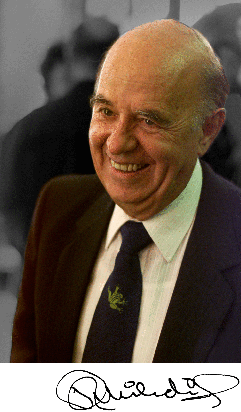Ricardo Miledi facts for kids
Quick facts for kids
Ricardo Miledi
|
|
|---|---|
 |
|
| Known for | deciphering the role of calcium in neurotransmitter release |
Ricardo Miledi (born September 15, 1927 – died December 18, 2017) was a famous Mexican neuroscientist. He is best known for figuring out how calcium helps brain cells send messages. He also created a way to study special parts of cells called receptors, using frog eggs. This helped in making new medicines.
Contents
Early Life and Education
Ricardo Miledi was one of seven children. He studied at the National Autonomous University of Mexico (UNAM). There, he earned degrees in both general studies and medicine.
While in medical school, Miledi realized he preferred research over treating patients. He thought he would spend too much time on each patient, trying to understand every tiny detail. He was very interested in how medicines worked.
Because of this, he chose to do research for his required social service. He worked at the "Instituto Nacional de Cardiología." There, he studied how electrical signals in the heart could cause problems. He became very good at careful lab work.
Discoveries and Research
In 1955, Miledi spent a summer at the Marine Biological Laboratory in Wood's Hole. He started studying how nerve cells communicate in squid. This is where he first saw how important calcium was for sending messages between nerves. Around 1956 and 1957, Miledi also did research in Australia.
Working with Bernard Katz
In 1958, he met Bernard Katz, a scientist who later won a Nobel Prize. Katz invited Miledi to work at University College London. There, Miledi studied how a chemical called Acetylcholine (ACh) is released. He also looked at the parts of cells that receive ACh, called receptors.
His studies showed something called "spillover." This is when neurotransmitters (brain chemicals) spread out and affect other areas. This work helped develop the idea of neuromodulation. This means how nerve cells can change or control how other nerve cells work.
Calcium's Role in Nerve Signals
In the early 1960s, Miledi became very interested in calcium again. He found that if there was no calcium, nerve signals would reach the end of a nerve, but no message would be sent. As soon as a little calcium was added, the message would be released.
Miledi and Katz published an important paper. It showed that calcium plays a major role in releasing ACh. More work with squid helped them understand even better how calcium helps nerve cells send messages.
Studying Damaged Nerves
Miledi's work also led to studies on denervation. This happens when nerves are damaged or cut off from the muscles they control. He studied frog muscles that had lost their nerve connection.
He found that special support cells, called Schwann cells, acted like helpful guides. They could take on some nerve activity and even release Acetylcholine themselves. This helped keep the connection between the nerve and muscle working.
Later Career and Innovations
Miledi became a Distinguished Professor at University of California, Irvine in the early 1980s. While there, he created a new method called microtransplantation. This technique allowed scientists to study receptors from human brain tissue after a person had died. This helped them understand brain diseases better.
He developed this method based on earlier work. He was the first to record electrical signals from a frog oocyte (egg cell). He found that these egg cells naturally had neurotransmitter receptors.
From the 1990s until he passed away, he was a Distinguished Professor at UNAM's Institute of Neurobiology in Querétaro, Mexico.
Awards and Recognition
Ricardo Miledi received many important awards for his work:
- He was chosen as a fellow of the British Royal Society in 1970.
- He received the King Faisal International Prize for Science in 1988.
- He won the Prince of Asturias Award in 1999.
- He received the Royal Medal in 1998.
- In 2010, he won the Ralph W. Gerard Prize from the Society for Neuroscience.
He was also one of the 42 founding members of The World Academy of Sciences in 1983. This group recognizes great scientists from developing countries.
See also
 In Spanish: Ricardo Miledi para niños
In Spanish: Ricardo Miledi para niños


